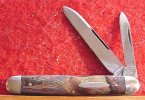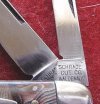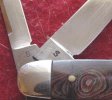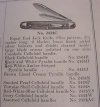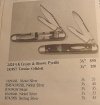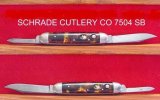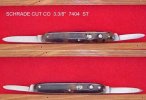Here is your update on your question which will answer some of your concerns but not all. Just to bring everyone up to date. I received 2 photos from Mr Fender. However they are much to large for me to post nor do I know how to reduce them and I gave up trying when my computer started making strange noises. However the pics did show the knife. I then asked Mr Fender to remeasure his knife since I felt it was a 3,1/8" knife rather than a 3". This was confirmed by Mr Fender upon remeasuring to be a correct assumption. This also confirmed the knife as a version of a 7424 pattern. I have attached pics of a similiar ( ie different colored celluloid handles ) patterned knife. This knife was also produced under Schrade Walden as a 742 ( when they went to 3 numbers from the Schrade Cut 4 numbers they often just eliminated the forth digit. ). I have also attached pics of the catalogue listing as it appeared originally and also a photo listing referenced from the Sargent 1 book.
The reverse tang stamp however remains an enigma it does appear to be a 10 on top of 100. I contemplated it for a while, I even considered that perhapes the one on top was really a worn E and that since the knife has a handle niche for the notch in the small blade perhapes it stood for Easy Open ( EO ). However I disregarded this notion. Also I know of no reference as a pattern 100 or a 10100 frankly nothing seemed to come to mind. Then upon a further examination of my knife I noticed that the back of its blades were marked with an S this also seemed rather strange. Since Stainless steel was usually denoted by SS. I feel the S may denote some kind of a sample. As far as the 10 over 100. I find it a bit of a quandry in that it might mean numerous things It could have been a designation for a special set or issue. While the knife in question does not seem to have had any advertising on the handles but it is tough to tell. If so that might have something to do with it. Schrade during this period did not engrave special numbers on the bolsters as they did later on so perhapes this was an alternative. I suppose i really should go over the back tangs of my other Schrade cuts to see what other odditys if any exist.
As I have said many times part of the fun of Schrades is that you never know what will show iup. Many of the original reasons for these inconsistencys have already been lost to history. One thing the 2 odd markings ( ie S on mine and 10 over 100 ) confirms is that for some reason they made some numbers of knives with what had to be speciality reverse tanged blades ( an interesting point by itself ) in that it means they may well have been tanged for specific and limited amount reasons. In the past i have found that when these types of questions pop up the answer ( if and when found ) is usually quite simple utilatarian and once known are logical and simple. It is just getting to the knowing part that is tough and there are very few people around anymore. who would simply remember the answers. I will continue to scout around. who knows? This specific tanging ( for perhapes a handful of various special blades ) would not be done today, bolsters now would be marked or blades electro etched. However in those days they would pound the tang in with a giant press right on the spot. I guess for just a couple of blades if they needed the mark.
Sorry I could not get 100 percent on this one however I do feel fairly confident on the model number and pattern. I hope this helps somewhat. LT PS Anyone with any info on these odd tangs who might wish to share ( this information ) would certainly be welcome.

